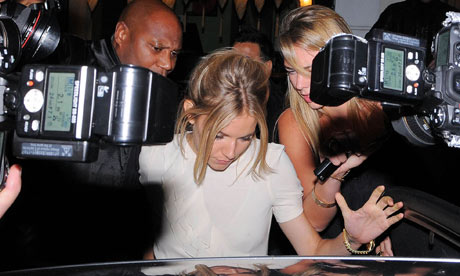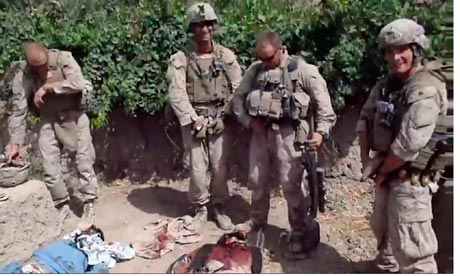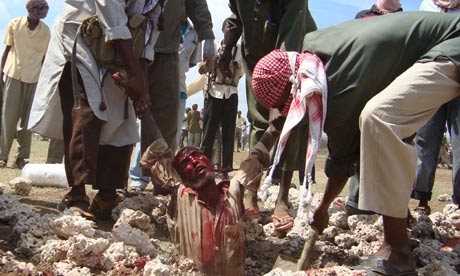
Relentlessly pursued ? Sienna Miller: ?I would often find myself, at the age of 21, at midnight, running down a dark street on my own with 10 men chasing me.? Photograph: Exposure Photos.com/JTBB
Musings by Shahidul Alam

“Weegee: Murder Is My Business” Through September 2.?International?Center of Photography, New York.
Weegee’s photographs are as much about Weegee as they are about crime.
By James Polchin

In the fall of 1978, the International Center of Photography mounted the first retrospective of Weegee photographs. Reviews of the show were positive, though the reviews often centered on debates about the artfulness of Weegee?s tabloid images. The?New York Times?critic began with the very conundrum of this tension between art and news photography: ?It is always faintly alarming to see the photographs of Weegee on exhibition at a museum or gallery. They were not made for exhibition but to be reproduced in tabloid newspapers.? Despite this beginning, the review affirms Weegee?s importance in American photography, and argues that his work influenced later artists such as Diane Arbus and Garry Winograd. Continue reading “If It Bleeds”


“To catch a death actually happening and embalm it for all time is something only cameras can do,” writes Susan Sontag in Regarding the Pain of Others, “and pictures taken out in the field of the moment of (or just before) death are among the most celebrated and often reproduced of war photographs.”
Sontag goes on to describe the context in which Eddie Adams took what was arguably the most shocking image of the Vietnam war: the moment in which a South Vietnamese police officer executes a Vietcong suspect by shooting him point-blank in the head. She points out that the picture was both authentic and staged ? “by General Loan, who had led the prisoner, hands tied behind his back, out to the street where journalists had gathered. He would not have carried out the summary execution there had they not been available to witness it”. Wearily, Sontag concludes that “one can gaze at these faces for a long time and not come to the end of the mystery, and the indecency, of such co-spectatorship”.
I was reminded of that final quotation when, a few weeks ago, I navigated the winner’s gallery of the World Press Photo of the Year website. There, amidst the many dramatic images of conflict, death and destruction, was a series by an Associated Press photographer, Farah Abdl Warsameh, entitled Stoned to Death, Somalia, 13 December. The four images are shocking in a way that even the most graphic war reportage seldom is any more. The first shows the victim being buried up to his neck in earth. The second shows a group of men, their faces concealed by headscarves, raining rocks down on his head. The third shows his bloodied torso being dragged out of the soil. The last shows the men hurling large rocks at his prone and lifeless body to finish off their gruesome ritual. There are no captions; we are left to guess the context.
One’s immediate instinct on coming upon the photographs is to recoil in horror, which is what almost everyone I showed them to did. A colleague described them as “a kind of pornography of suffering”. (The Sunday Times ran the series last week in their Spectrum section devoted to the World Press awards. Many readers were outraged and appalled.)
Last week, in a blogpost for Foto8 magazine, the veteran picture editor, Colin Jacobson, wrote that “the rather disgusting pictures ? raised some interesting ethical matters”, which is one ? somewhat understated ? way of putting it. More problematically, Jacobson said that “obviously there was collaboration between the photographer and those carrying out this gruesome death sentence”. Perhaps. But what kind of collaboration? Unlike the shooting of the Vietcong suspect, the dreadful execution of the Somalian man would seemingly have gone ahead at that time had the photographer not been present. (Other images from the series, not included in the World Press selection, show an audience of villagers who had gathered to witness the execution.) On that level, the photographer did not collaborate with the killers, though he almost certainly gained permission from someone to shoot the stoning. He also shot every stage of the killing in all its protracted and torturous barbarity. What it takes to do that, and at what personal cost, only he can say.
Images as extreme as these beg so many questions about the morality of reportage. Did the photographer, one wonders, have any communication with the victim in the time leading up to the event? Would our reaction to the photographs be different if we knew that the condemned man granted the photographer permission to bear witness to his dreadful death? Would it be different if we knew that the photographer risked his own life to travel though strife-torn Somalia to bear witness, which, as one of the respondents to Jacobson’s blog points out, was probably the case. Does such extremity diminish us or enlighten us? Or simply shock us into a kind of impassioned helplessness?
Part of the complex power of these photographs comes from what Sontag calls the “provocation” inherent in all images of real suffering. The first of many questions they ask is: “Can you look at this?” Perhaps Sontag comes closest to articulating the moral dilemma at the heart of extreme images of suffering when she writes: “There is shame as well as shock in looking at the close-up of a real horror. Perhaps the only people with the right to look at images of suffering of this extreme order are those who could do something to alleviate it ? or those who could learn from it. The rest of us are voyeurs, whether or not we mean to be.”